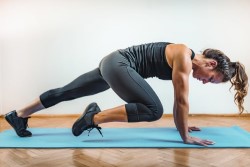You don't go to the gym to get mediocre results. You train with determination to make the most of every rep, every run, and every drop of hard-earned sweat. This is good news for you because scientists and researchers are asking the same questions. These highly effective strategies based on the latest research will help you get the most out of every workout.
1. Weightlifting

If you're just doing cardio, prepare for failure. Losing weight becomes more difficult because your metabolism actually decreases. A person's metabolism can be increased through resistance training rather than aerobic exercise. In a 12-year study of 10,500 people at the Harvard School of Public Health, those who did 20 minutes of strength training a day accumulated less belly fat (compared to those who did the same amount of cardio).
2. Listen to music.

While everyone knows that listening to their favorite music can encourage you to exercise, research published in the Indian Journal of Physiology and Pharmacology found that people who listened to music (especially slow music) after exercise were more likely than those who listened to music after exercise. Recover faster Don't do this. Music has been shown to increase levels of dopamine and serotonin in the body, two hormones that aid in recovery. Play some of your favorite songs the moment you're done working out and ready to unwind. This medication helps you return to normal heart rate and blood pressure as quickly as possible, allowing you to recover faster.
3. Alternate active warm-ups and stretches.

Don't overwork yourself to save time and energy. A study conducted by Austin State University showed that after a warm-up with squats and light leg extensions, the weight of the squat increased by 8.36%. Additionally, their lower body was 22.7% more stable. Consider a rubber band. If you stretch it a lot and then pull back to shoot it, it will go shorter. The same thing happens to your tendons and muscles. In contrast, using a dynamic bodyweight program (much like your upcoming workout) increases circulation and improves range of motion without affecting the elastic properties of muscles and tendons. For example, if you plan to run, it's a good idea to warm up with lunges, knee raises, and leg swings for 5 to 10 minutes before getting on the treadmill.
4. Carbohydrates are a great way to start exercising.

As a marathon runner, you may be considering using carbohydrates to improve your time. However, a 2013 study published in Sports Medicine suggests that eating carbohydrates before exercise can also help you during these phases of high-intensity exercise. The main source of energy for any high-intensity workout is carbohydrates. When your body gets the proper amount of energy, it's more likely to exert itself and get more benefits from exercise than fasting, both in terms of muscle gain and calorie expenditure. No matter how much you enjoy your early morning workout, a little oatmeal or toast before heading out will help.
5. Fai intervallo

High-intensity interval training (HIIT), in which short bursts of high-intensity exercise are alternated with slower, less intense "rests," produces optimal cardiovascular and fat-burning results per minute. Research from the Human Performance Lab at the University of Wisconsin-La Crosse found that those who did 20-minute interval training, including push-ups, lunges, burpees and other variations, burned an average of 15 calories per minute — nearly twice as much as Like those who run far away. To get the same results, follow the instructions for the exercise: Repeat as many times as you can for 20 seconds, then rest for 10 seconds, then repeat for a total of 4 minutes. Repeat four times, resting one minute between each round.
6. Drink water

Losing 2% of body weight in fluids is possible (although some sweat as high as 6-10%), but with more exercise, worse performance and less recovery after leaving the gym. Unfortunately, we find that many people who go to the gym are dehydrated by the time they go to the gym. Weighing before and after sweating helps ensure you're drinking enough water to replace any fluid you lose during your workout. Weight loss should not exceed 2% of body weight.
7. Work out with free weights.

Weight machines are great for teaching proper form to newbies in the gym, but once you've mastered them, it's time to move on to free weights and improve your fitness. According to a 2014 study published in the Journal of Strength and Conditioning Research, activities involving free weights such as dumbbells, barbells, and kettlebells produce a greater hormonal response than exercising on gym equipment. Because free weight exercises involve a wider variety of muscles, they are more effective than weightlifting exercises. When you need to lift free weights without the help of a machine or other guidance or support system, your synergistic muscles need to fire to help you.
8. Get a good night’s sleep.

The ability to sleep well is essential to getting the most out of your workout time at the gym. This also applies to every night of the week. If you don't get enough sleep, your body can't repair itself and get stronger after each activity. That's according to research published in the Journal of the American College of Sports Medicine in 2015. Adequate sleep is essential for hormonal changes that increase the body's ability to recover from physical activity. Symptoms of overtraining, such as B. Fitness platforms develop when you don't get enough sleep. Aim for seven to nine hours of sleep each night.